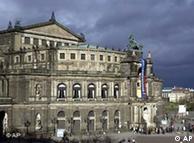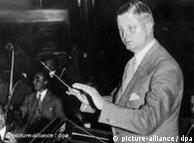When I come to write the definitive history of English eccentricity — a subject I have lived with all my life — I will definitely allocate a chapter to Martin and Lizzie Graham. Other people have shrubs in their garden. The Grahams are growing something a little larger: a bicentenary production of Wagner’s Ring. All four operas and 15 hours of it. Staged in a converted chicken barn in rural Gloucestershire.
It will cost them about a million quid, plus the rest — because nothing with the word “Wagner” attached comes budget-priced. They don’t get a penny of public subsidy, and have precisely three years to raise the money, because for some reason the Germans are insistent that Wagner’s bicentenary can’t be shifted from 2013. The whole project is blissfully barmy. Welcome to the topsy-turvy world of
Longborough Festival Opera.
The Grahams are an engaging couple. Martin grew up in Longborough,didn’t excel at school and became a builder’s mate. He’s now one of the leading property developers in the Midlands. He met Lizzie, a former English teacher, at a party. “I was impressed by his talk about literature,” she says. “Only later did I find out how few books he had actually read. He marshalled his knowledge extremely cleverly.”
In the 1990s both became fascinated by opera in general and Wagner in particular. But whereas most Wagner obsessives spend their summers in Bayreuth and try to lead normal lives for the rest of the year, the Grahams felt the urge to do something much stranger. They decided to present Wagner in their garden. “I thought ‘This is so simple’, because we already had the barn,” Martin says.
The obvious people to consult were Georg Solti, the greatest Wagner conductor of his day, and George Christie, the owner of Glyndebourne, the oldest country-house opera festival. “Solti wrote back saying ‘You must be bonkers’ and Christie said, ‘I think you need help’.” What sort of help he didn’t specify.
Undeterred, the Grahams set about converting the barn into a theatre. A friend suggested that they give it a fake Palladian front — in pink. Cotswold District Council went collectively apoplectic, but the Grahams finally prevailed. The 480 seats came as a job lot from the Royal Opera House, which was being refurbished.

And the rest? Well, each year Martin adds another little touch to his grand project. Statues of great composers over the portico. New loos. Fancier boxes. A deeper orchestral pit (“I’ve dug out a bit more this year,” he says). More dressing rooms. Brick by brick, his old barn is looking more and more like a real opera house. And, because it’s on a ridge, the views are breathtaking. Emerge from Figaro and you can see three counties laid out like a map in front of you.
The annual festival runs for six weeks from mid-June and stages everything from Mozart to Britten. But the gleam that started the whole thing — Wagner’s Ring — hasn’t been sidelined. In 1998 the Grahams presented a “pocket” Ring: an ingenious condensing of the score by the British composer Jonathan Dove. But that was just a warm-up. In 2007 they mounted a full-scale Rhinegold. “To call it a triumph would be an understatement,” I enthused in these pages. Some props looked as though they had been plucked from a car-boot sale. Bayreuth it wasn’t. But it was sung and staged with a thrilling, almost ferocious passion.
Now the second instalment of Longborough’s Ring is ready. On July 24 the Valkyrie will swoop on the Cotswolds for three performances. In keeping with the incongruity of the place, Wotan will be played by a former fireman — a brilliant Welsh baritone, Jason Howard. The plan is that Siegfried will follow next year,Götterdämmerung in 2012 and two cycles of the whole Ring in 2013.
It’s breathtakingly risky. The Grahams have raised their ticket prices for Die Walküre: £70-£145, rather than the £35-£110 range for non-Wagner nights. But that will produce a box-office take of only about £125,000 — and the show’s budget is £225,000. The gap has to be covered by donations. For the Ring in 2013 the gap will be much bigger. “We will need a £1 million injection,” Lizzie says. “But it can’t be put off,” Martin adds firmly. “We have to take the plunge.”

Three cheers for that. The arts world is far too corporate these days. Committees, consultants, assessors, accountants, boards, bureaucrats: it sometimes seems that no performance can happen without years of discussion by hundreds of bean-counters. Longborough is heartwarming evidence that, with a dash of “can do” spirit, a lot of resourcefulness, energy and an endless supply of English eccentricity the mightiest cultural projects can flourish, on a shoestring, in the oddest places.
But they do need that million quid. The last time I looked, the Cotswolds were full of weekending City types stashing their million-pound bonuses. I don’t wish to cast aspersions. But wouldn’t a donation to Gloucestershire’s very own Ring cycle be a good way to show that you aren’t socially useless after all?
Read more at
The Times Online  If you wish to try it out, go directly to the TSO "subscribe to email" page by clicking here (direct url: http://www.tso.ca/Plan-Your-Experience/EMail-Club.aspx.
If you wish to try it out, go directly to the TSO "subscribe to email" page by clicking here (direct url: http://www.tso.ca/Plan-Your-Experience/EMail-Club.aspx. If you wish to try it out, go directly to the TSO "subscribe to email" page by clicking here (direct url: http://www.tso.ca/Plan-Your-Experience/EMail-Club.aspx.
If you wish to try it out, go directly to the TSO "subscribe to email" page by clicking here (direct url: http://www.tso.ca/Plan-Your-Experience/EMail-Club.aspx.

























atkibblepalace,glasgowbotanicgardenscredittommyga-kenwan.jpg)
















